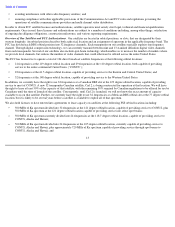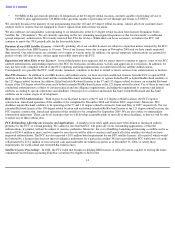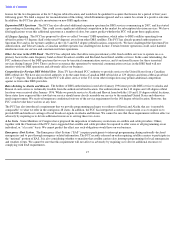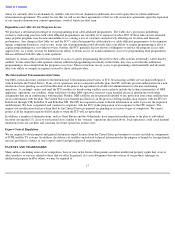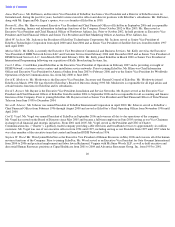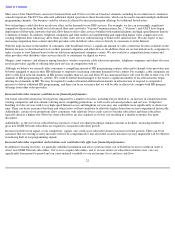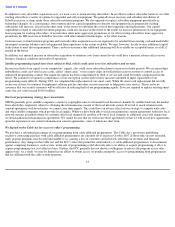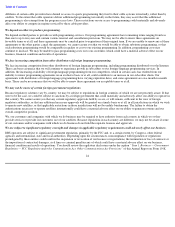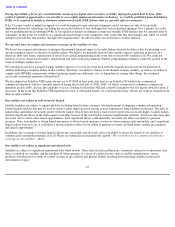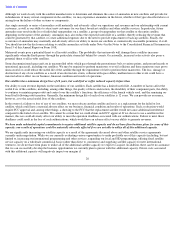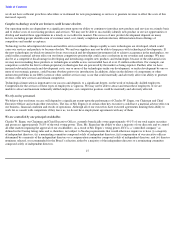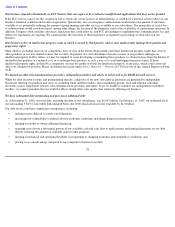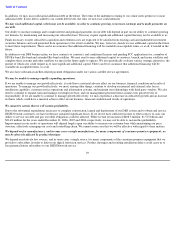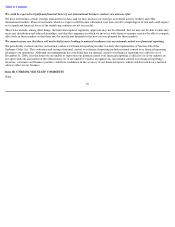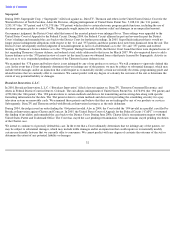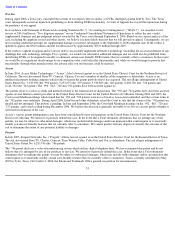Dish Network 2007 Annual Report Download - page 30
Download and view the complete annual report
Please find page 30 of the 2007 Dish Network annual report below. You can navigate through the pages in the report by either clicking on the pages listed below, or by using the keyword search tool below to find specific information within the annual report.
Table of Contents
In addition to new subscriber acquisition costs, we incur costs to retain existing subscribers. In an effort to reduce subscriber turnover, we offer
existing subscribers a variety of options for upgraded and add on equipment. We generally lease receivers and subsidize installation of
EchoStar receiver systems under these subscriber retention programs. We also upgrade or replace subscriber equipment periodically as
technology changes. As a consequence, our retention and our capital expenditures related to our equipment lease program for existing
subscribers will increase, at least in the short term, to the extent we subsidize the costs of those upgrades and replacements. Our capital
expenditures related to subscriber retention programs could also increase in the future to the extent we increase penetration of our equipment
lease program for existing subscribers, if we introduce other more aggressive promotions, if we offer existing subscribers more aggressive
promotions for HD receivers or EchoStar receivers with other enhanced technologies, or for other reasons.
Cash necessary to fund retention programs and total subscriber acquisition costs are expected to be satisfied from existing cash and marketable
investment securities balances and cash generated from operations to the extent available. We may, however, decide to raise additional capital
in the future to meet these requirements. There can be no assurance that additional financing will be available on acceptable terms, or at all, if
needed in the future.
In addition, any material increase in subscriber acquisition or retention costs from current levels could have a material adverse effect on our
business, financial condition and results of operations.
Satellite programming signals have been subject to theft, which could cause us to lose subscribers and revenue.
Increases in theft of our signal, or our competitors’ signals, also could cause subscriber churn to increase in future periods. We use microchips
embedded in credit card-sized access cards, called “smart cards,” or in security chips in our EchoStar receiver systems to control access to
authorized programming content. Our signal encryption has been compromised by theft of service and could be further compromised in the
future. We continue to respond to compromises of our encryption system with security measures intended to make signal theft of our
programming more difficult. During 2005, we completed the replacement of our smart cards. While the smart card replacement did not fully
secure our system, we continue to implement software patches and other security measures to help protect our service. There can be no
assurance that our security measures will be effective in reducing theft of our programming signals. If we are required to replace existing smart
cards, the cost could exceed $100.0 million.
Our local programming strategy faces uncertainty.
SHVIA generally gives satellite companies a statutory copyright license to retransmit local broadcast channels by satellite back into the market
from which they originated, subject to obtaining the retransmission consent of the local network station. If we fail to reach retransmission
consent agreements with broadcasters we cannot carry their signals. This could have an adverse effect on our strategy to compete with cable
and other satellite companies which provide local signals. While we have been able to reach retransmission consent agreements with most local
network stations in markets where we currently offer local channels by satellite, roll-out of local channels in additional cities will require that
we obtain additional retransmission agreements. We cannot be sure that we will secure these agreements or that we will secure new agreements
upon the expiration of our current retransmission consent agreements, some of which are short term.
We depend on the Cable Act for access to others’ programming.
We purchase a substantial percentage of our programming from cable-affiliated programmers. The Cable Act’s provisions prohibiting
exclusive contracting practices with cable affiliated programmers are currently set to expire in October 2007. If those rules are not extended,
many popular programs may become unavailable to us, causing a loss of customers and adversely affecting our revenues and financial
performance. Any change in the Cable Act and the FCC’s rules that permit the cable industry or cable-affiliated programmers to discriminate
against competing businesses, such as ours, in the sale of programming could adversely affect our ability to acquire programming at all or to
acquire programming on a cost-effective basis. Further, the FCC generally has not shown a willingness to enforce the program access rules
aggressively. As a result, we may be limited in our ability to obtain access (or nondiscriminatory access) to programming from programmers
that are affiliated with the cable system operators.
23


